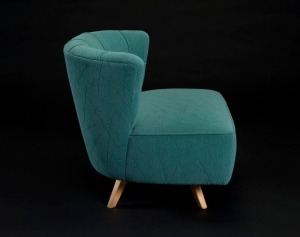What is organic upholstery and why should I care?
This is a common question in my work, which includes new design as well as reclamation and customization of vintage upholstered furniture. We offer the option of organic & sustainable upholstery materials – an important choice for those who are chemically sensitive, as well as those looking to create a cleaner indoor environment.
It is helpful to know what kinds of questions to ask your furniture dealer or upholsterer when purchasing new furniture or rehabilitating your favorite sofa or chair. Confusion runs rampant with the current trend toward greenwashing everything from vitamins to kitchen sinks, partly due to a lack of guidelines which consumers can trust. Oecotextiles, an organic textile manufacturer who walks the talk, addresses this issue in some depth in their blog.

Our certified organic wool comes from a local sheep ranching and wool producing operation
Not all upholstery materials are available as certified organic products, so we have to do the best we can by offering the “next best thing” alongside the certified products, while keeping an eye to the horizon for new and better options as they become available. The certified organic products we are currently using in our new and reclaimed pieces include cotton batting, and locally produced wool felt & batting. (Note: we are addressing the inside padding materials here; cover fabrics will be explored in a later post).
The wool batting may be covered with a layer of organic cotton/bamboo batting or an organic cotton ticking fabric to prevent ‘migration’ of the wool fibers through the cover fabric.

Certified organic wool batting and felt wrapped over a hemp canvas base layer
The remaining fabrics we are currently using are non-organic natural fibers, including hemp canvas used as a base layer over the springs. Natural latex foam may be used as a padding layer or as the core of a cushion. Latex is produced by tapping the rubber tree, much like the tapping of a maple tree for maple syrup – the process does not harm the tree.
Both wool and latex are widely touted as natural barriers to dust mites, mold & mildew, which are known allergen sources in many home environments.
Read Full Post »


















